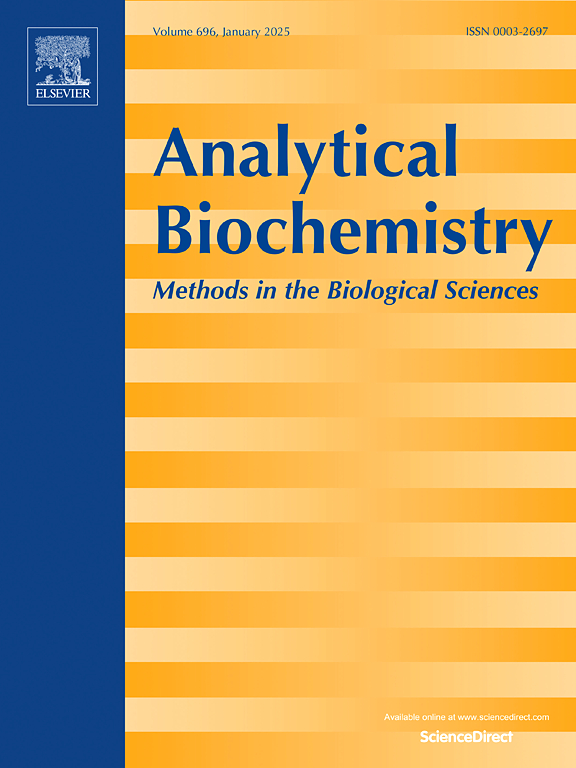Development of a high-sensitivity double kinetic assay for creatinine using the enzymatic cycling method and its application to serum samples
IF 2.5
4区 生物学
Q2 BIOCHEMICAL RESEARCH METHODS
引用次数: 0
Abstract
Estimated glomerular filtration rate (eGFR) is often used as a measure of renal function in clinical practice owing to its simplicity. Serum creatinine levels are essential for eGFR calculation. Although the Jaffé method is widely used for creatinine measurement, it exhibits low specificity and sensitivity. Development of various enzyme methods has increased its specificity; however, its sensitivity is still insufficient for accurate eGFR calculation. To overcome this issue, we developed a highly sensitive assay for creatinine detection using enzymatic cycling reaction in this study. Our method consisted of two steps: Endogenous ammonia elimination and creatinine analysis. NADH derived from creatinine changed the water-soluble tetrazolium salt-8 color in the presence of the electron carrier, 1-methoxy-5-methylphenazinium methylsulfate. The cycling oxidation–reduction of 1-methoxy-5-methylphenazinium methylsulfate to NADH facilitated the coloration of water-soluble tetrazolium salt-8, aiding in creatinine measurement with high sensitivity. The within-run reproducibility of the developed method was good (<1.76 % at each concentration tested), with a detection limit of 1.00 μmol/L, making it approximately 9 times more sensitive than the Jaffé method. Notably, its correlation with the high-performance liquid chromatography method was excellent (r = 0.976). Overall, this study successfully developed a new, rapid, simple, and highly sensitive method for creatinine analysis.

酶循环法测定肌酐高灵敏度双动力学分析方法的建立及其在血清样品中的应用
估计肾小球滤过率(eGFR)由于其简单,在临床实践中经常被用作肾功能的测量。血清肌酐水平是计算eGFR的必要条件。虽然jaff法被广泛用于肌酐的测定,但其特异性和敏感性较低。各种酶法的发展提高了其特异性;但其灵敏度仍不足以精确计算eGFR。为了克服这一问题,我们在本研究中开发了一种高灵敏度的酶循环反应肌酐检测方法。我们的方法包括两步:内源性氨消除和肌酐分析。由肌酐衍生的NADH在电子载体1-甲氧基-5-甲基吩嗪甲基硫酸盐存在下改变了水溶性四氮唑盐-8的颜色。1-甲氧基-5-甲基吩嗪甲基硫酸酯循环氧化还原为NADH,促进了水溶性四氮唑盐-8的显色,有助于高灵敏度测定肌酐。该方法重现性好(各检测浓度均为1.76%),检出限为1.00 μmol/L,灵敏度比jaff法提高约9倍。与高效液相色谱法的相关性极好(r = 0.976)。总之,本研究成功地开发了一种新的、快速、简单、高灵敏度的肌酐分析方法。
本文章由计算机程序翻译,如有差异,请以英文原文为准。
求助全文
约1分钟内获得全文
求助全文
来源期刊

Analytical biochemistry
生物-分析化学
CiteScore
5.70
自引率
0.00%
发文量
283
审稿时长
44 days
期刊介绍:
The journal''s title Analytical Biochemistry: Methods in the Biological Sciences declares its broad scope: methods for the basic biological sciences that include biochemistry, molecular genetics, cell biology, proteomics, immunology, bioinformatics and wherever the frontiers of research take the field.
The emphasis is on methods from the strictly analytical to the more preparative that would include novel approaches to protein purification as well as improvements in cell and organ culture. The actual techniques are equally inclusive ranging from aptamers to zymology.
The journal has been particularly active in:
-Analytical techniques for biological molecules-
Aptamer selection and utilization-
Biosensors-
Chromatography-
Cloning, sequencing and mutagenesis-
Electrochemical methods-
Electrophoresis-
Enzyme characterization methods-
Immunological approaches-
Mass spectrometry of proteins and nucleic acids-
Metabolomics-
Nano level techniques-
Optical spectroscopy in all its forms.
The journal is reluctant to include most drug and strictly clinical studies as there are more suitable publication platforms for these types of papers.
 求助内容:
求助内容: 应助结果提醒方式:
应助结果提醒方式:


